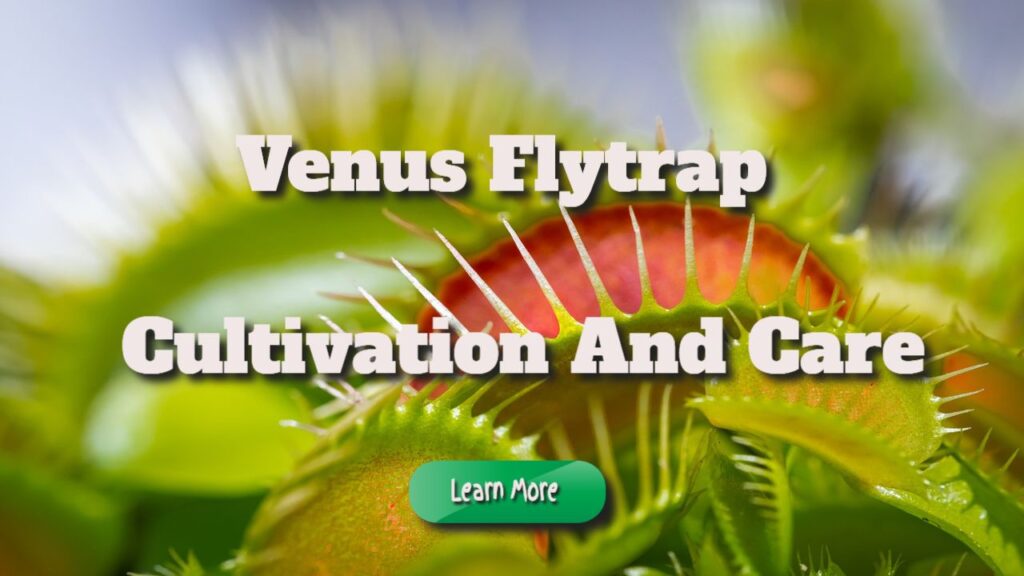Venus Flytrap Cultivation and Care
Venus Flytrap Cultivation and Care
Venus Flytrap Cultivation and Care: A carnivore that grows best as a houseplant
The Venus flytrap (Dionaea muscipula) is one of the most bizarre plants on the planet. People grow it for its effect rather than its appearance:
It feeds on flies.
This makes it one of the most beautiful plants to grow, especially for children who can spend hours watching it “eat.”
A Venus flytrap’s “trap” is a modified leaf. A plant can have up to eight of these, which grow from flat stems (technically part of the leaf) that form a rosette at the base.
The Venus flytrap isn’t the only plant with a modified leaf. The purple pitcher plant is another example (Sarracenia purpurea subsp. purpurea).
This leaf is made up of two lip-like lobes connected by a hinge. The nectar inside the trap serves as bait, luring the bug inside, where it dies.
The trap is triggered when the insect within touches one of the trigger hairs: it closes and traps the prey inside.
Enzymes digest the bug between 4 to 10 days.
The “jaws” reopen after digestion.
Venus flytrap is the common name for the Venus flytrap.
Dionaea muscipula is the botanical name.
Droseraceae family
Perennial plant species
6-12 cm tall, 6-9 cm broad at maturity
Full or partial sun exposure
Sandy and damp soil
Acidic soil pH
Flowering season: spring and summer
White flower colour
Zones 5-8 for Winter Hardiness (USDA)
North American native
Venus Flytrap Maintenance
Because Venus flytrap is bred to be viewed up close, it is commonly cultivated as a houseplant in a container, where you can examine its peculiar behaviour more easily.
The care of a Venus flytrap is not more complex than that of many other houseplants, but it does necessitate particular circumstances.
This carnivorous plant must be fed live flies, mosquitoes, and gnats. Using tweezers, gently insert the bug into the trap until it touches a trigger hair.
Because a Venus fly trap may only open and close a certain number of times throughout its lifetime, keeping track of when you feed it is essential.
Remove the blossoms when the plant begins to bloom in May or June. Flowering leads to seed formation, which depletes the plant’s energy.
Venus flytrap is grown for its carnivorous effect rather than its blossoming beauty.
Light
If you want your container plant to thrive, you must ensure it gets at least 12 hours of sunlight per day from spring through fall. Four of those hours should be spent outside in the sun.
Soil
Wild Venus flytraps live in bogs with moist, acidic, nutrient-depleted soil. Indoors, replicate this with peaty potting soil and sufficient drainage.
Water
The Venus flytrap thrives best when watered with rainwater rather than regular tap water.
Install a rain barrel or keep a container outside to catch rainfall. If rainwater is not available, distilled water should be used.
Fertilize
Fertilize not. Venus flytrap grows best on nutrient-deficient soil. 3 Just like it does in its natural bog habitat.
Venus flytrap species
Plant breeders have produced many types of this odd plant. Cultivars have colourful names that accentuate the strange nature of the Venus flytrap.
These cultivar names are generally quite descriptive, emphasizing a specific feature that distinguishes the cultivar from the numerous others. Here are several examples:
Dionaea ‘Petite Dragon’: this Venus flytrap is one of the smallest, measuring barely half an inch in diameter.
Dionaea ‘Ginormous’: At the opposite end of the range, the traps of this type measure 2.25 inches in diameter.
Dionaea ‘DC All Red’: Color is the most noticeable distinction between the many species of Venus flytraps. Most traps contain at least some green, and some are entirely green.
Others may include a mix of red, yellow, green, and purple. The ‘DC All Red’ variation is entirely red.
Propagation
The simplest and most dependable way of propagating the Venus flytrap is division.
In early spring, mature plants will produce offshoots. Carefully cut them off at the base without damaging the roots.
For growing medium, fill pots 4 to 5 inches wide and at least 6 inches deep with new peat. A hole through the centre of each pot is required.
Fill the holes with the cuttings. Maintain a consistently moist soil temperature, and water them frequently.
Before new roots have been established, protect the container from direct sunshine but still give the plant some light.
WARNING
Wild populations of Venus flytrap, like those of other native species, have fallen dramatically owing to over-collection and habitat loss.
This plant should never be picked in the wild, only from nurseries that propagate their plants.
The Venus flytrap is being potted and repotted.
The Venus flytrap requires a more acidic soil mix than conventional houseplant mixes. Because peat moss acidifies the soil, a mixture of soil and peat moss or horticulture sand and an equal amount of peat moss works well.
Because they have a low pH, wood products such as bark, sawdust, or wood fibres are a viable and sustainable alternative to peat moss.
Ensure that the wood has not been chemically treated. Because its pH is virtually neutral, coconut fibre, a sustainable alternative to peat moss, is unsuitable.
It is unproductive to fertilize plants.
Overwintering
The plant undergoes a dormant phase in the fall when daylight hours and sunshine diminish. It subsequently loses its leaves and appears to die, although it lives underground via rhizomes.
This is normal, and you should not use artificial light to compensate for decreased daylight hours.
Reduce the amount of water and place the plant in the most fantastic room of your home. Give it just enough water to keep the soil from drying out completely.
When the plant begins to develop again in early spring, resume frequent watering to keep it moist at all times.
Common plant pests and diseases
You may assume that a bug-eating plant would be immune to pests, yet aphids and fungus gnats occasionally attack the Venus flytrap.
The plant cannot collect and eat these bugs because they are too little. If aphid infestations are severe, horticultural oil or insecticidal soap can help.
Bacillus thuringiensis (BTI) can be used to control fungus gnats naturally.
FAQ
Can a Venus fly trap cause harm to humans?
Even if you accidentally insert your finger into one of the traps, the effect is not severe enough to hurt you.
However, avoid the urge to poke your finger in the trap, as this would deplete the plant’s energy, which should be used to catch and eat insects.
The plant does not contain poison for pets.
Where did the name “Venus flytrap” come from?
Because the plant bears gorgeous white blossoms, the genus name (Dionaea) and the first half of the common name are connected to the Roman goddess of love.
The species name muscipula (Latin for “mousetrap”) most likely alludes to the closing “jaws,” which, when released, resemble a mousetrap.
Where is the Venus flytrap indigenous?
Only in the Carolinas can you find them.





The Venus flytrap truly is a fascinating marvel of nature, and I appreciate how you highlighted its unique feeding mechanism. It’s intriguing to think about how such a peculiar plant has captured the imagination of so many, particularly children. Watching a trap close on an unsuspecting fly can evoke a sense of wonder about the complexities of the natural world.
You’re spot on about the Venus flytrap! It really does spark that sense of awe, especially when you see it in action. Watching the trap snap shut is like witnessing a little piece of nature’s drama unfold right before your eyes.
It’s true; there’s something captivating about how the Venus flytrap operates, making it a perfect gateway for exploring the wonders of nature, especially for kids. When you see it spring into action, you can’t help but feel that sense of amazement. It’s like a tiny little predator in a world we often think of as passive plant life. Plus, its unique adaptations raise questions about survival and evolution that can spark curiosity about the ecosystem as a whole. Not only does it catch flies, but it also plays a role in its environment that’s often overlooked. How do you think such unique survival strategies might influence young minds to appreciate nature more?
I’ve always found Venus flytraps to be absolutely fascinating! There’s something uniquely captivating about a plant that actively catches and digests insects—it’s like having a mini predator right on your windowsill. I remember getting my first flytrap as a child and being mesmerized by the way it would spring shut when a fly ventured too close. It really sparked my love for strange and exotic plants.
I’ve always found the Venus flytrap fascinating, not just because of its insect-eating antics, but because it sparks such curiosity and conversation, especially among kids. There’s something almost magical about watching a plant that actively engages with its environment. It’s like a little reminder of how diverse and complex nature can be. I remember the first time I saw one ‘eat’—I was totally captivated! It draws you in, doesn’t it?
I get what you’re saying about the Venus flytrap. There’s something truly intriguing about a plant that interacts with the world around it in such a dynamic way. It’s not just a passive organism; it’s actively hunting and responding to stimuli, which feels quite extraordinary.
I completely get what you mean about the Venus flytrap being captivating. There’s something almost hypnotic about its mechanism, right? Watching it snap shut in response to an unsuspecting insect feels almost like witnessing a tiny piece of nature’s drama. I remember my first encounter as well—it’s one of those moments that sticks with you.
I love how you’ve highlighted the unique qualities of the Venus flytrap! They’re fascinating little plants, and I find it amazing how they serve as a great hands-on science lesson for kids. My niece was so captivated when she saw one in action at a botanical garden—she couldn’t get over how a plant could ‘eat’!
It’s true—the Venus flytrap definitely has a flair for the dramatic, doesn’t it? I mean, it’s like the Houdini of the plant world, pulling off tricks that would make most of us do a double take. I can only imagine your niece’s reaction when she saw the trap snap shut. It’s like watching a plant version of a superhero in action.
Your exploration of the Venus flytrap really highlights its unique appeal—not just as a plant but as a window into the complexities of nature. I remember the first time I watched a flytrap catch its prey; it felt almost like witnessing a small miracle. It’s fascinating how these plants have adapted to their environment, evolving to derive nutrients from insects in nutrient-poor soils.
Your exploration of Venus flytrap cultivation and care really resonates with me, especially as someone who has always been fascinated by plants that possess unique adaptations. There’s something inherently captivating about the Venus flytrap, not just because of its carnivorous nature, but also the way it embodies the delicate balance of life in nature. Watching it “eat,” as you noted, can turn into an enlightening experience for children and adults alike – it opens up dialogues about ecosystems, food chains, and the amazing strategies that plants have developed to survive.
It’s great to hear that you connect with the Venus flytrap on that level. There’s something truly fascinating about how these plants have evolved. I mean, they’re not just sitting there looking pretty—they’ve turned their need for nutrients into a whole hunting strategy. It’s a wild twist on plant life that definitely sparks curiosity.